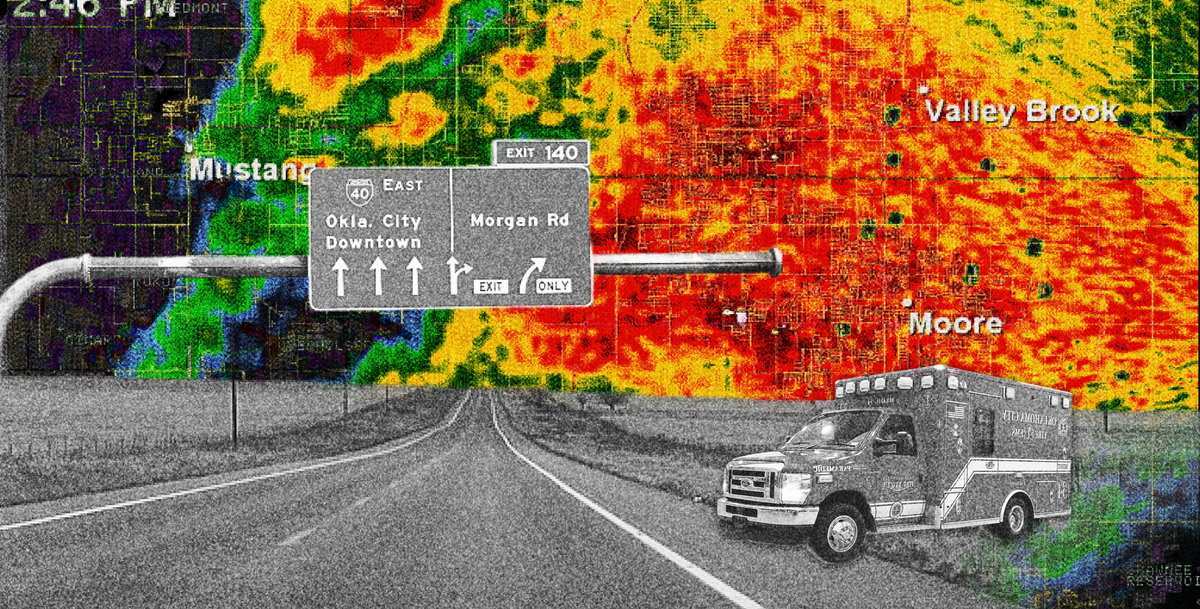Turbulence in Weather Community over Oklahoma Bill

It’s an ambulance! It’s a firetruck! It’s a storm chaser?
Drivers in Oklahoma may need to be on the lookout for a new type of emergency vehicle if Oklahoma Senate Bill 158, introduced in the state legislature on Feb. 3 by state Sen. Mark Mann (D-Oklahoma) and state Rep. Scott Fetgatter (R-Oklahoma), is signed into law.
Breaking down Oklahoma’s storm tracking bill
The bill, dubbed Oklahoma Emergency Weather Response and Tracking Regulatory Act of 2025, would require chasers to receive a severe weather tracker license for driving into severe weather events. These chasers would be categorized as “Professional Severe Weather Trackers,” who, according to the bill, is an individual or company hired or contracted by a “qualified media outlet” or a research program at a “qualified institution for higher education.”
The bill specifies that a “qualified media outlet” includes broadcast television stations licensed by the Federal Communication Commission. This does not, however, include radio and audio stations.
Examples of “qualified media outlets” in Oklahoma include KFOR TV, KJRH TV, KOCO 5 News, OKC Fox, KSWO 7 News, KTUL ABC 8, News 9, and News on 6.
The bill defines a “qualified institution for higher education" as any college or university regulated by the Oklahoma State Regents for Higher Education that offers a course or program in meteorology.
The Oklahoma State Regents for High Education comprises 25 colleges and universities. Among those, only one school, the University of Oklahoma, offers a course in meteorology.
These licensed chasers would chase significant weather events, which the bill defines as:
- A day of slight, enhanced, moderate, or high severe weather risk categorized by the National Oceanic Atmospheric Administration or the Storm Prediction Center in one or more counties in Oklahoma
- Any tornado or severe weather watch issued by the National Weather Service or chief meteorologist employed by a qualified media outlet
- A tornado or severe thunderstorm warning in one or more counties issued by the NWS or chief meteorologist in a qualified news outlet
- Tornado or several thunderstorm-warned storms that are anticipated to enter Oklahoma as a high-end dangerous storm from neighboring states within a given period
- A blizzard warning, ice storm warning, winter weather advisory, winter storm warning, or winter storm watch issued by the NWS or a qualified media outlet
- A red flag fire warning declared by the NWS or the Oklahoma Forestry Services of the Oklahoma Department of Agriculture, Food, and Forestry
- A flash flood warning or flood warning, issued by the NWS or the chief meteorologist employed by a qualified news outlet
To obtain a storm tracker license, you must pay a $500 fee and renew it by the end of the calendar year for $250. If you don’t comply with the bill’s provisions, you will need to pay a fine of $500, and your tracker license will be revoked.
The bill designates chasers as “emergency vehicles.” Therefore, once someone obtains a license, they can use audible and visual signals on the road.
Due to the emergency vehicle designation, chasers would be able to use a Code 3 response, which is an emergency response, utilizing lights and sirens. In a severe weather event, drivers on the road would need to yield the right-of-way to approaching permitted chasers.
The bill also states that the vehicle must display markings identifying that it is used for severe weather tracking and specify the qualified media outlet or institution of higher education that the tracker is associated with.
The professional tracker will also be allowed to traverse roads, highways, and country roads closed by the Department of Transportation, Oklahoma Turnpike Association, any city or county, or any law enforcement agency due to the severe weather event.
The intent of the bill
“I was sitting in my father’s home with my wife back in June and I hear the sirens go off in my hometown. I’m watching the weather — it’s a really bad, stormy night — there’s not a single watch in my hometown. There’s no tornado warning in my hometown,” Fetgatter said in a Feb. 6 interview on Youtube.com/@StormFrontFreaks with seven meteorologists and storm trackers.
During the June severe weather event, Fetgatter said there was no discussion on the television about a possible tornado in his town and the surrounding area. Shortly after the sirens ended, he said a tornado warning popped up on the news. Nobody was hurt, and there wasn’t any major damage, but Fetgatter said he thought about that night when constituents asked him to run this bill.
Fetgatter said his aim in creating this bill was to allow chasers to approach a red light, yield, and then drive through the light without any repercussions from local law enforcement. He wants this bill to enable chasers to get to a storm as fast as possible and quickly relay data to local broadcast stations and the National Weather Service.
“Every second that you all sit in a traffic light is a second that storm is moving away,” Fetgatter said in the interview. “And that somebody is potentially in harm's way.”
The controversial part of the bill
“The big problem this bill does is that it authorizes untrained civilians to run a Code 3,” Warren Faidley, storm chaser and photojournalist, said. “When you have people running emergency traffic through major cities like Oklahoma City with no experience and in rural highways, where it’s already crowded, you could already guess what will happen.”
According to a report on ambulance crashes by FEMA, 45.7% of the reported fatal crashes from 2012 to 2018 occurred during emergency use of the ambulance and 28% occurred when lights and sirens were active.
“So there’s absolutely no reason for that (Code 3),” Faidley said, referring to the report. “It’s not going to save anything. It’s just going to endanger everyone else and clog the road with people trying to pull over or get out of the way.”
Faidley, a certified EMT who has been in emergency vehicles during a Code 3, said it’s frightening to be in an emergency response situation.
“To run at those speeds through intersections and cities — even the cops will tell you that you can have all the training in the world, but it takes years of experience to get that sense of running Code 3,” Faidley said.
Faidley said he would not want to run a Code 3 during a storm chase because of the heightened chances of hurting someone on the road. He said he already sees how dangerous chasing is without the bill because "chasers get so amped up to get to the storm first that all logic goes out the window."
“There’s plenty of footage of them passing and hydroplaning and crashing,” Faidley said. “It’s a nightmare.”
Last month, Faidley was at the Palisades fire in California, where he said he experienced the easiest press access ever to any severe weather event. He said Oklahoma can follow suit and revise its bill to match California’s media access law.
“California traffic is some of the worst you can imagine. You’re talking total gridlock,” Faidley said. “The way they tackled this is they have an equal media access law, which means when the roads are blocked and when you need to get around traffic and there’s police there, the media are let in.”
Influence of local media on the bill
“We’re getting a lot of pushback from people that this (bill) is being pushed by some local media to help their T.V. numbers,” Erik Fox, field reporter for Weather Nation TV, said to Fetgatter in the Youtube interview. “And so my question to you is if that’s the case and they’re influencing this, what influence is that and what safety regards do you have for people outside the state?”
“Whoever asks me to run the legislation, I feel obligated to make sure that they are at least engaged in every aspect of the conversation going forward and I will tell you that it was a local media group that requested the bill. For T.V. ratings or not, I don’t know,” Fetgatter said. “I will just tell you from a common sense point of view, it makes sense to me that we should have a discussion about storm chasers being able to get through a specific area to make sure that they can keep up with the storm.”
Val and Amy Castor, storm trackers from Oklahoma News 9, have been vocal about their support for this proposed legislation. On Facebook, Val said this bill does not change the storm-chasing community as a whole.
“It is designated to give them (qualified research chasers and qualified media chasers) a higher level of visibility and safety on the road, and to be more efficient at doing their job of relying accurate, timely, and potentially life saving information to the public,” Val said on Facebook.
Faidley said Mike Morgan, chief meteorologist at KFOR TV, opposes the bill. He said the reasoning for that is probably the liability that the stations would be under and the safety aspects of the legislation.
“I think certainly in terms of higher institutions of education, especially right here in Oklahoma, these folks already know exactly what they're doing and they have for 50+ years,” Morgan said in a Jan. 31 KFOR interview.
Morgan later said in the interview that media storm chasing has been around since the late 1970s and early 1980s, so this is not a new topic. He said everything in this bill is subject to “a lot of debate and a lot of fine-tuning.”
Now what?
The House Business Committee voted 9-0 on Feb. 4 to continue the bill in the state legislature. It must go through other committees and could be amended before a final vote.
If the legislation is passed, Faidley said it might be challenged as a violation of the First Amendment in the U.S. Constitution.
“If this bill passes, we’re going to see it all over,” Faidley said. “Texas, Kansas, all the chase states. One of the big things chasers are worried about is this will ignite a firestorm of preventing chasers from getting out there and doing what they need to do.”





